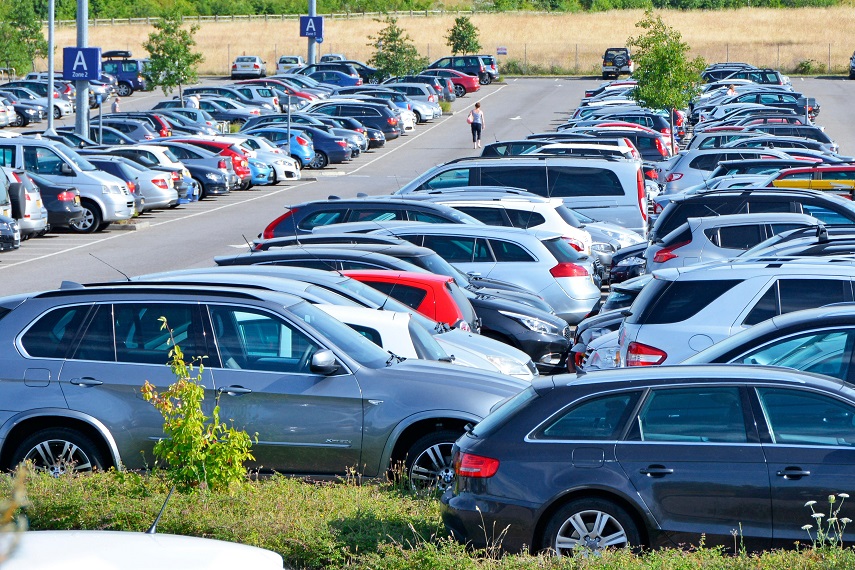
1. Description of Autonomous Parking System
For a long time, people have hoped that self-driving cars can be realized. When you arrive at a destination such as an office building, shopping mall or amusement park, you get off at the gate, and your “well-trained” car will go to the parking lot to find a parking space and lock it. When you are ready to go home, the fast communication on your smartphone will drive your car back to the front door, allowing you to get in the car and go home. This kind of automatic valet parking and its convenience will truly allow people to enjoy the convenience and efficiency of self-driving car technology. Ultrasonic distance measurement system, reversing image and electric power steering control and fuzzy control are its core technologies.
The Independent Parking System (ระบบที่จอดรถ) is a new product that developed and grew at the same time as autonomous driving technology at the beginning of this century. Although the spatial awareness of urban traffic arterial roads and branch lines is particularly strong, parking on the edge of the road is regarded as a legal solution at home or abroad. It can often be encountered, but it is a difficult technique, especially when When road managers plan the parking spaces to be compact and narrow, they must ensure that the high reliability of parking is implemented.
Many years ago, the French National Automobile Institute (INRIA) built the first prototype car, which solved the problem of parallel parking in the urban environment, whether it is on the side of the road or in the community. This is an important area of research on autonomous vehicles, and it also lays the foundation for the commercial application of autonomous parking in vehicles today. There are 3 types of parking. Figure 3 is a vertical parking, the parking space shown is perpendicular to the vehicle’s course of travel. The other type is the vehicle delivery conveyor belt, which enters the stereo garage and sorts in place.
The 21st century has opened a new era of automotive intelligent technology. Leading by intelligent manufacturing technology, various industries have entered the Industry 4.0 era, making full use of the combination of information and communication technology, cyberspace virtual systems and cyber-physical systems to transform the manufacturing industry into intelligence. The autonomous parking system, which is part of the third level of unmanned vehicles, is based on the automatic parking assistance system APA (Automatic Parking Assistance System) developed in the 1980s, which has been continuously popularized and promoted.
The two main hardware groups of the APA system are the control unit and the ultrasonic radar probes located on the front and rear bumpers and on both sides of the body. Press the automatic parking assist system activation button, and the radar probe will operate at low vehicle speeds (30km/h) and a lateral distance of 1.5 The scan is successfully completed within about m. The automatic parking assist system, when there are columnar obstacles such as street light poles and small and medium-sized trees beside the parking space, in order to prevent the risk of collision caused by radar detection errors, the system will not be activated at this time. The front, rear, left, and right radar probes measure the distance and angle between the vehicle itself and surrounding objects. The driver only needs to control the speed of the vehicle. The on-board computer calculates the operation process and adjusts the steering wheel rotation according to the speed of the vehicle to enter the parking space by itself, but the gear and braking still need to be Human control has not yet achieved full intelligence.
Whether for a novice or an experienced driver, parking in a parking space is a relatively inadvertent link in the driving process that requires special attention, especially when encountering a narrow parking space. In recent years, an intelligent and cooler configuration has appeared on some new models. It can judge the parking space by itself and automatically park the car, which is the automatic parking assist system APA. It includes reversing radar, reversing image, 360-degree holographic image and other configurations, and has become the standard configuration of mid-to-high-end cars. For example, Ford Focus Hatchback (Ford Focus Hatchback), domestic Volkswagen Touran, Passat cc, Skoda Haorui, Toyota Crown, Mercedes-Benz, BMW, Lexus LS and other models, most of them use the key developed by INRIA The basic system designed by the technology array. Therefore, INRIA’s research results have become the general standard of the Society of Automotive Engineers (SAE) J3016 Standard.
Statistics on the traffic accident database and accident claims of insurance companies show that parking accidents account for more than 30% of all traffic accidents, and 1/2 to 3/4 of them are caused by reversing parking collisions. Today, scientists have used deep neural networks to further decipher human thinking and imagination. Artificial Intelligence (AI: Artificial Intelligence) is approaching the human brain, and the realization of autonomous parking systems has become possible.
2. Basic Principles of Autonomous Parking System
2.1 Construction of APS
The autonomous parking system consists of 3 functional blocks:
①Environmental data acquisition system, including image acquisition and vehicle-mounted distance detection system, transmits the data of the distance between the image and the vehicle body and obstacles to the central processing unit through the data line;
②The CPU analyzes and processes the data, makes an autonomous parking strategy based on the current position of the vehicle, target position and surrounding environment parameters, and converts it into electrical signals;
③After receiving the electrical signal, the vehicle strategy control execution system will instruct the vehicle to control the direction, angle and power support of the vehicle.
Autonomous parking systems need to be applied to many sensors that can support autonomous driving and are installed throughout the body, including vehicle radar (lidar system), visual CCD cameras and ultrasonic sensor probes, as well as global positioning systems.
Radar is used for automatic cruise control, collision warning, parking and aligning assistance, and provides map information to facilitate automatic vehicle navigation and detection of pedestrians, bicycles and other obstacles; vision cameras are in charge of reversing safety, blind spot monitoring, lane keeping and Anti-fatigue, etc.; use ultrasonic to detect the surrounding environment of the vehicle, measure the distance to other vehicles and obstacles, and form an environmental data acquisition system.
After the vehicle obtains the appropriate parking space information, the CPU software system commands the operation of the hardware, and the vehicle can be parked in the parking space, and the display (or buzzer) is equipped to notify. Figure 6 depicts the use of radar and ultrasonic technology in vehicles by Analog Devices, Inc. in the United States, working in APS.
1) The parking positioning system (PTS) reads information such as the vehicle speed, gear status, ignition switch status, etc., activates the distance sensor and warning components, and communicates with the CAN network through the Flax Ray bus.
2) The control unit of the electric power steering mechanism and the steering column control module reads the steering wheel angle and steering angle speed, communicates with the CAN network through the Flax Ray bus, and links the electronic control unit ECU.
3) APS also needs to be linked to the vehicle stability system control unit, and by analyzing the signals transmitted by the sensors, it sends accurate control instructions and error corrections to anti-lock braking (ABS) and acceleration and anti-skid control (ASR) to ensure that the vehicle is maintained in good condition. The dynamic balance has the best stability under various conditions. When a rear-wheel drive vehicle flicks due to oversteer and loss of control of the rear wheels, ESP will slightly brake the outer front wheels to stabilize the vehicle (at this time, the wheels will lock due to reduced wheel speed); when understeer, ESP will quickly Slightly brake the inner rear wheel to correct the direction of travel.
Ford Motor uses Infineon’s SAK-XC2336B-40 F8 0L AA central processing unit. Based on the principle prototype that has been developed, the project combines the requirements of the product prototype to conduct system reliability research, matching test and The optimization of the production process to improve the stability and reliability of the system, reduce costs, and meet the performance of the product. The American industry believes that Infineon is a leader in research on key technologies of autonomous parking systems. A block diagram of Infineon’s autonomous parking system is shown in Figure 7, and the product picture is shown in Figure 8.
The product’s performance indicators: the maximum parking speed is 10km/h; the parallel distance with the other two adjacent cars at the target parking position is 30cm; the minimum parking space length is 1.5 times the length of the body; the normal operating temperature is -40 ~85℃, storage temperature is -40~125℃; ECU has passed relevant environmental and mechanical tests and has conventional protection functions such as overcurrent, overvoltage, and short circuit.
Contacted sensors: Hall sensor (displacement information); acceleration sensor (acceleration information); ultrasonic sensor (obstacle distance information); CCD camera (parking space size, obstacle situation information); angular velocity sensor (left and right corner angular velocity information) Provide instructions for left and right rotation angles).
2.2 The core technology and operation of APS
2.2.1 Ultrasonic ranging is a time difference ranging method
The ultrasonic transmitter emits ultrasonic waves in a certain direction and starts timing at the same time. The ultrasonic wave will immediately return when it encounters an obstacle, and the ultrasonic receiver will immediately stop timing when it receives the reflected wave. The actual distance between the transmitting point and the obstacle can be calculated from the ultrasonic propagation speed in the air and the time difference between the ultrasonic transmission and reception. The formula is: S=1/2(Ct)
In the formula: C-the speed of ultrasonic propagation in the air (related to temperature); t-the time difference between ultrasonic transmission and reception (not only related to the selection of the single-chip microcomputer, and the higher the timer accuracy, the more accurate the measurement result).
The ultrasonic propagation velocity has a positive linear relationship with the temperature, and the sound velocity increases by 0.607m/s for every 1°C increase in temperature.
Therefore, the corrected actual wave velocity V=(331.5+0.607t)m/s, where t is the real-time temperature measured by the temperature detection circuit.
2.2.2 The networking relationship of each control unit in the CAN data bus
Started by the man-machine interface of the man-machine interaction system and display the parking process in real time. The functional module of the environment collection system is composed of ultrasonic ranging, radar cruise, vehicle detection, CCD camera and gyroscope (measure the actual position and width of the parking space, and evaluate the vehicle Can it be accommodated in the center of the parking space? In addition to the PTS and ESP mentioned in the previous section, the following control units must also be enabled to communicate with the CAN bus to achieve APS parking control: ①Anti-lock braking system (ABS) control unit, which realizes deceleration and braking, and obtains vehicle displacement information; ②Steering column electronic device control unit, obtains the information of a certain parking space of the vehicle, and prepares for automatic steering; ③Power-assisted steering composed of steering torque sensors, etc. The control unit realizes the automatic steering function of the vehicle.
2.2.3 Parking path planning and control
Parallel parking is commonly used to plan and design a feasible expected path trajectory by determining a common normal plus a tangent arc, and manipulating the vehicle to move along the expected path into the target parking space, as shown in Figure 12.
However, this solution requires very high working accuracy of sensors and actuators, and it is difficult to compensate for the dynamic errors of system operation, so it will turn to fuzzy control technology built on the experience of skilled drivers.
2.2.4 Fuzzy control technology
Fuzzy control technology is an important branch of intelligent control. It is a control theory based on fuzzy set theory in modern control theory that gives simulation algorithm language rules and fuzzy reasoning. Fuzzy control has strong robustness, and the influence of interference and parameter changes on the control effect is greatly weakened. It is especially suitable for the control of nonlinear, time-varying and pure lag systems. Fuzzy control does not require a complete and accurate mathematical model of the controlled object, so it is a good control method for the controlled object that is difficult to create a model, such as APS. Robustness characterizes the insensitivity of the control system to characteristic and parameter disturbances. Robustness makes the system stable under abnormal, dangerous and misoperation conditions. The reliable operation of APS’s dynamic detection system and fuzzy compensation system is guaranteed.
At present, the use of senior drivers’ parking experience and knowledge is realized by transforming it into fuzzy control. The operation process is: ①Find a parking space; ②Turn toward the parking space; ③Turn in the reverse direction toward the parking space; ④Adjust the posture in the parking space in 4 steps. The key ③, ④ these two links can only be qualitative here, and the quantitative content such as steering angle, direction, start and stop, etc., skilled drivers are originally handy to operate, and it is difficult for others to copy and describe. The completeness of fuzzy control rules and the global optimality of the membership functions of fuzzy variables are more difficult to guarantee.
2.2.5 Summary
Based on the combination of path planning and empirical knowledge, it not only has the accuracy of path planning, but also is compatible with the robustness of empirical knowledge fuzzy control. It is the current industry in-depth research program. As shown in Figure 13, design a parking planning path with a circular arc and a common tangent. Choose 4 key points (P1, P2, P3, and P4) on this path as the target of attitude adjustment.
From the shape and posture information of the parking process, extract n (such as 1 2 or 16) enough feature models as the feature function model to describe the parking dynamic behavior. The parking strategy of the senior driver is determined by the fuzzy control technology. , Constructed into a set of control modes. After starting to enter the autonomous parking procedure, the current vehicle characteristic state will be compared and identified based on the prior knowledge of the characteristic model and the real-time deviation between the vehicle pose and the parking target, and the optimal characteristic state driving station will be identified. Corresponding control modes to imitate the coarse and fine adjustments of experienced drivers during parking; and by controlling the vehicle speed and front wheel steering, the vehicle tracks each “path key point” one by one, and commands and controls the electric power steering system EPS, and then Control the rotation of the vehicle’s steering wheel and control the speed of the vehicle at the same time to perform parking operations, gradually and securely and autonomously parking into place, realizing anthropomorphic autonomous parking intelligent control.
Conditions for APS activation: ①The speed of the vehicle is less than 15 km/h; ②When the vehicle is parked in parallel on the side of the road, the angle between the longitudinal axis of the vehicle and the curb (the angle θ in Figure 13) should be greater than 20°.
This process uses the data information transmitted by various sensors, and uses the fusion algorithm of path planning, driving distance and driving speed to control the movement of vehicles one by one to the predetermined key points. The operation process can be shown in Fig. 14, and Fig. 15 is a control flow chart of the combination of path planning and fuzzy control.
2.3 System flow chart
Figure 16 is a flowchart of the operation of an autonomous parking system powered by a battery. Fuzzy control needs to first establish the kinematics model of the front wheel steering of the car, set the corresponding input and output variables, design their own membership functions and fuzzy control rule tables, and build a multi-dimensional fuzzy controller.
3. APS system characteristics and application examples
Vehicles currently available in China, such as Shanghai Volkswagen Tiguan, Mercedes-Benz B200, FAW-Volkswagen CC, Skoda Haorui, FAW Toyota Crown, and Lexus LS, are equipped with automatic parking assistance systems. For example, Mercedes-Benz B200, when a suitable parking space is detected, the system will display “P” to prompt, engage reverse gear, the system will display “Park Assist Activate”, press the up arrow on the left side of the steering wheel That is to say, the subsequent tasks will be completed by the vehicle itself. The driver only needs to brake to control the speed of the vehicle and pay attention to the distance between the vehicle and the front and rear vehicles. After the B200 completes the parking action, the wheels automatically return to the right, and the driver does not need to make any adjustments. It should also be noted that after the B200 enters the automatic parking state, the driver cannot touch the steering wheel with both hands, otherwise the system will automatically stop.
This automatic parking system is mainly composed of two parts: the control unit and the ultrasonic radar probes located on both sides of the front bumper. After pressing the semi-automatic parking assist system activation button, the radar probe can scan both sides of the vehicle while the vehicle is driving. The parking space can be scanned successfully at a speed of 30km per hour and a lateral distance of 1.5m. But when there are trees, street light poles and other pillars next to the parking space, in order to avoid the risk of collision due to errors in radar detection, the auxiliary system will not be activated at this time.
Autonomous parking is not required for manual intervention. Autonomous parking control is the first step for driverless fully automatic vehicles. Tesla, Nissan, Ford Land Rover, and Jaguar have all exhibited APS prototypes that can be controlled by remote control, that is, autonomous parking can be completed without any driver input. In January 2017, at the CES (International Consumer Electronics) exhibition held in Las Vegas, USA, several products that are currently at the forefront of one-key autonomous parking, such as BMW’s new generation 7-series sedan, were displayed. The system named Fully Automate Remove Valet (Fully Automate Remove Valet), does not require driver control at all, and automatically parks and enters the space. Even if it corresponds to a multi-storey large parking lot, the system can perfectly execute the parking instructions.
The computer comprehensively judges the environmental data information scanned by the radar scanner installed on the vehicle body, the structure of the parking lot itself, and the real-time parking status data information. The vehicle can intelligently find the parking space, perform the parking task, and lock the vehicle. During the parking process, unexpected situations in the parking lot, such as pedestrians, children intruding, and illegal parking, can be handled safely and calmly. Not only can it detect and measure the distance between the vehicle owner and the vehicle, and inform the vehicle owner; when the vehicle owner needs to pick up the vehicle, he can accurately drive to the vehicle owner’s drop-off location on time at the time predetermined by the vehicle owner, allowing the vehicle owner to board the vehicle and drive away.
Tesla Summon autonomous parking is implemented in the upgraded version of Model S. It not only solves tasks such as parallel parking and vertical parking, but also handles garage doors equipped with HomeLink that have been set up, allowing private garage doors to open automatically when entering and exiting. closure.
In this field, Audi, Volvo, and Ford have also performed well. For example, Audi claims that if its autonomous parking technology is fully promoted, the space required for parking each car will be saved by 25% (2m2), so that the garage can be parked. The number of vehicles will be 1.5 times that of the present. The economic and social benefits will be very significant.
These well-known automobile manufacturers often directly use or rely on the relevant functional modules (including joint development) of the reputable automotive electronic device multinational companies. Such as Infineon (Infineon), Analog Devices (Analog Devices, Inc. referred to as ADI), Texas Instruments (TI), STMicroelectronics (ST Microelectronics) and other mature products developed by APS, these automotive electronic device suppliers’ APS Dedicated devices or modules have a good price/performance ratio.
4. Application prospects of APS
The intelligent APS can become a module that can be independently called by the entire automotive intelligent system. It can automatically select the corresponding parking plan according to the real-time on-site situation, and can start parking from any starting point, which has considerable complexity and innovation.
The software system established by fuzzy control, neural network, genetic algorithm and particle swarm optimization algorithm is recognized as the most promising software for APS. It can fully consider the parameters of various environments and its own factors, and plan and calculate an effective and feasible path. Generate a control command, control the steering wheel to rotate, and instruct and guide the vehicle to follow the path to complete the autonomous parking operation.
As early as 2012, Nissan applied 4G network and cloud computing technology to network NSC-2015 vehicles (Figure 5) to realize intelligent autonomous parking, which was the most advanced level at the time. Autonomous parking system is a sub-topic of autonomous vehicles. Today, data communication has turned its perspective to 5G and millimeter wave communication, which will surely bring bright prospects to the development and commercialization of APS. A car with a low degree of self-driving will only alert the driver of a potential collision at a dangerous moment, while a car with a high degree of self-driving will automatically brake or avoid it. But even if the degree of automatic driving is high, the car cannot exist without the communication system, because if you want to achieve fully automatic driving, it cannot be achieved without a high-precision map. This means that the car must obtain the latest information and data from the map server in real time at any time. In-vehicle communication systems have always been the basic safety communication and traffic management methods for automobiles. After the use of wireless communication technology in automobiles, applications begin to support basic safety, traffic efficiency, and Internet access. The vehicles are in V2V (vehicle-to-vehicle) mode and V2I ( Direct communication is realized under the vehicle-to-roadside infrastructure) mode.
Radar is mainly used for functions such as automatic cruise control, collision warning, parallel assist, and parking; visual cameras are responsible for reversing safety, blind spot monitoring, fatigue prevention, and lane keeping; the main task of lidar is to provide high-precision map information , So that the car can complete automatic navigation and find pedestrians and bicycles in time.
The scope of these technologies depends on the hardware configuration and deployment environment. If driving in the suburbs, the radar’s range can reach 200m, the lidar also has 35m, and the vision camera is 30m. If you change to an urban environment, due to traffic jams and numerous obstacles, the detection range of these hardware will be reduced to only a few meters, not more than 10m.
External sensors will be subject to their “sight”, but if you add ultra-high-speed communication, the vehicle’s sensing range will be greatly increased, because vehicles from all directions can provide it with important information.
If the sensor on a vehicle detects a bicycle, it will transmit its position and speed to other vehicles. If the transmission rate is high, it may send less raw information for processing, and other vehicles need to integrate processing based on the data collected by their own sensors. Therefore, having a high-speed and low-latency communication system enables rapid exchange of processed and unprocessed information.
5 Conclusion
The autonomous parking control of artificial intelligence technology greatly reduces the difficulty of parking, saves time, avoids the risk of collision during parking, and enables vehicles to complete parking operations quickly, accurately and safely. With the progress of human society, the commercialization and popularization of autonomous parking systems are an inevitable direction, and they will also produce excellent economic and social benefits. Low-cost, high-performance autonomous parking systems have very broad market prospects.









